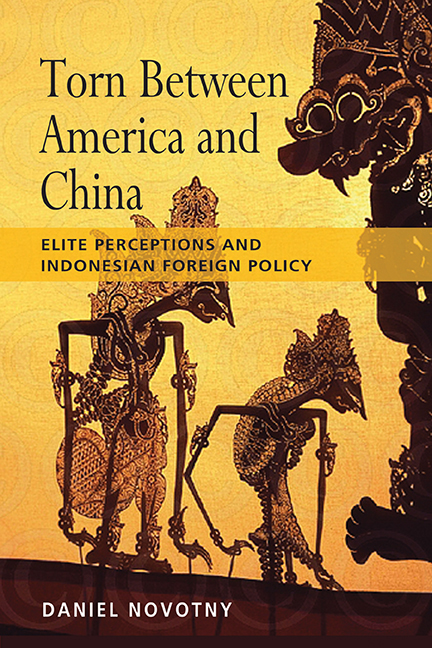Book contents
- Frontmatter
- Dedication
- Contents
- Foreword
- Preface
- List of Figures
- Acknowledgements
- PART I THE CONTEXT
- PART II THE PERCEPTIONS “ANTARA DUA KARANG”
- PART III ELITE CONSENSUS AND POLICY OUTCOMES
- 6 The Bigger Picture: Elite Perceptions of Other Powers
- 7 The Indonesian Elite Facing a Changing World
- 8 Conclusion
- Glossary
- Abbreviations
- Bibliography
- Index
- Note on the Author
7 - The Indonesian Elite Facing a Changing World
from PART III - ELITE CONSENSUS AND POLICY OUTCOMES
Published online by Cambridge University Press: 21 October 2015
- Frontmatter
- Dedication
- Contents
- Foreword
- Preface
- List of Figures
- Acknowledgements
- PART I THE CONTEXT
- PART II THE PERCEPTIONS “ANTARA DUA KARANG”
- PART III ELITE CONSENSUS AND POLICY OUTCOMES
- 6 The Bigger Picture: Elite Perceptions of Other Powers
- 7 The Indonesian Elite Facing a Changing World
- 8 Conclusion
- Glossary
- Abbreviations
- Bibliography
- Index
- Note on the Author
Summary
INTRODUCTION
In this chapter, we will attempt to address the following main question that this book tries to answer: “To what extent can the dynamics of Indonesian foreign relations in the post-Cold War period be explained in terms of the threat perceptions held by the country's foreign policy elite?” While the text aims to bring together both the theoretical and empirical aspect of this book, the discussion primarily draws on a set of assumptions and principles on which the balance of threat theory is based. In particular, this chapter aspires to prove that the dynamics of the Indonesian elite's foreign policy decision-making can be explained by means of the balance of threat concept. The theory is thus employed as an analytical tool by which to qualitatively and quantitatively evaluate the empirical findings from the 2004–06 research. As suggested in Chapter 2, one of the main arguments behind the balance of threat theory is that leaders’ perceptions of a particular country always need to be placed in the broader context of the elite's worldview. Importantly, from the Indonesian perspective, both at the elite level and public at large, the country's relationship with the United States and China can be viewed in a triangular form. Thus, in line with the “mendayung antara dua karang” thesis, it is possible to argue that we cannot understand Indonesia's approach towards the U.S. unless we place the country's relationship with the U.S. in the context of the Indonesian elite perceptions about the rise of China — and vice versa.
As argued in preceding chapters, a major determinant that shapes the elite's foreign policy preferences is the degree of the leaders’ agreement about the nature and urgency of the threat. The elite's consensus about the threat determines what foreign policy tool will be employed to deal with a particular danger to the state's security. Consequently, to provide a better understanding of the role of elite perceptions on the foreign policy decision-making process, this chapter also addresses a second important question: “Is the Indonesian elite unanimous in its view of the world, which has been the official version and policy of the country's consecutive administrations, or is the elite divided in its foreign policy perception?”
- Type
- Chapter
- Information
- Torn between America and ChinaElite Perceptions and Indonesian Foreign Policy, pp. 299 - 345Publisher: ISEAS–Yusof Ishak InstitutePrint publication year: 2010

